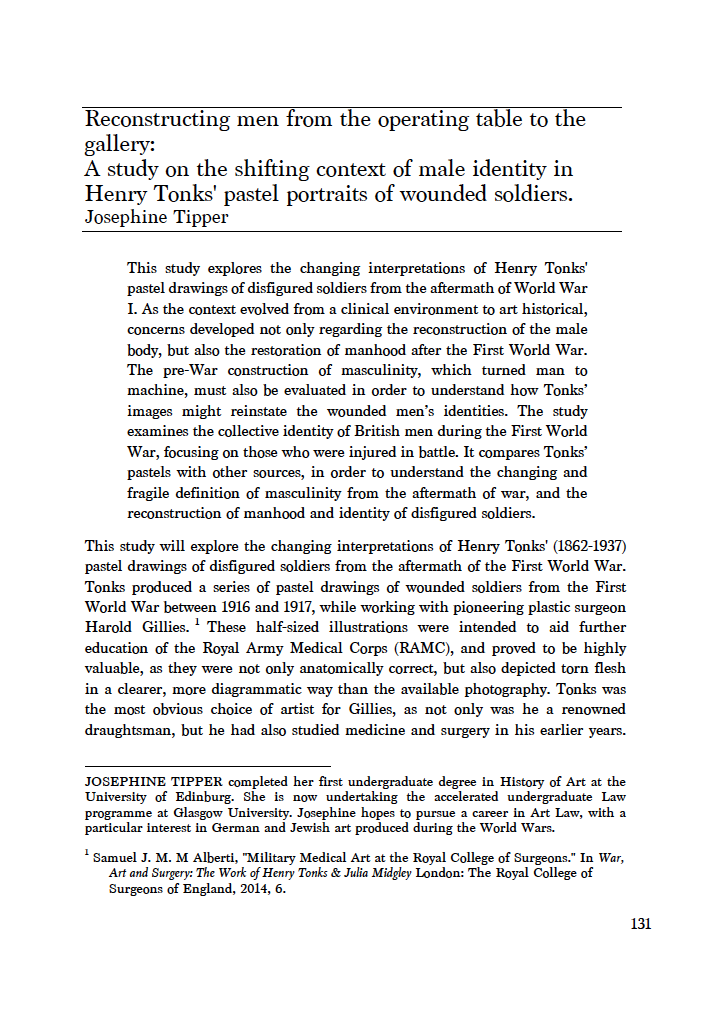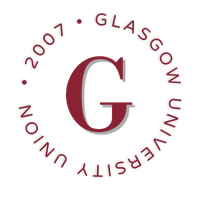Reconstructing men from the operating table to the gallery
A study on the shifting context of male identity in Henry Tonks' pastel portraits of wounded soldiers
DOI:
https://doi.org/10.36399/GroundingsUG.10.193Keywords:
Henry Tonks, World War I, Masculinity, Facial Reconstruction, Wounded Soldiers, Battlefield Art, PastelAbstract
This study explores the changing interpretations of Henry Tonks' pastel drawings of disfigured soldiers from the aftermath of World War I. As the context evolved from a clinical environment to art historical, concerns developed not only regarding the reconstruction of the male body, but also the restoration of manhood after the First World War. The pre-War construction of masculinity, which turned man to machine, must also be evaluated in order to understand how Tonks’ images might reinstate the wounded men’s identities. The study examines the collective identity of British men during the First World War, focusing on those who were injured in battle. It compares Tonks’ pastels with other sources, in order to understand the changing and fragile definition of masculinity from the aftermath of war, and the reconstruction of manhood and identity of disfigured soldiers.
References
Alberti, Samuel J. M. M, "Military Medical Art at the Royal College of Surgeons." In War, Art and Surgery: The Work of Henry Tonks & Julia Midgley (London: The Royal College of Surgeons of England, 2014).
Anzieu, Didier, "The Skin Ego." New Haven and London: Yale University Press, 1989.
Bamji, Andrew, "Facial Surgery: The Patient's Experience." In Facing Armageddon, edited by Hugh Cecil and Peter H. Liddle. London: Leo Cooper, 1996.
Biernoff, Suzannah, "A Necessary Humanity." In War, Art and Surgery: The Work of Henry Tonks & Julia Midgley, edited by Samuel J. M. M Alberti. London: The Royal College of Surgeons of England, 2014.
Biernoff, Suzannah, "Flesh Poems: Henry Tonks and the Art of Surgery." Visual Culture in Britain 11 (2010): 25-47.
Biernoff, Suzannah, "Shame, Disgust and the Historiography of War." In Shame and Sexuality: Psycho-Analysis and Visual Culture, edited by Claire Pajaczkowska and Ivan Ward. London: Routledge, 2008.
Biernoff, Suzannah, "The Rhetoric of Disfigurement in First World War Britain." Social History of Medicine 24 (2011): 666-85.
Bourke, Joanna, Dismembering the Male: Men's Bodies, Britain and the Great War. London: Reaktion Books, 1999.
Carden-Coyne, Ana, Reconstructing the Body: Classicism, Modernism, and the First World War. Oxford: Oxford University Press, 2009.
Chambers, Emma, "Fragmented Identities: Reading Subjectivity in Henry Tonks' Surgical Portraits." Art History (2009): 578–607.
Chambers, Emma, "Wounded Soldiers and the Memory of War." In In War, Art and Surgery: The Work of Henry Tonks & Julia Midgley, edited by Samuel J. M. M Alberti. London: The Royal College of Surgeons of England, 2014.
Freud, Sigmund, "The Ego and the Id." In Standard Edition of the Complete Psychological Works of Sigmund Freud, edited by James Strachey. London: Hogarth, 1961.
Gilman, Sander L, Making the Body Beautiful: A Cultural History of Aesthetic Surgery. Princeton: Princeton University Press, 1999.
Hall, Donald E, Muscular Christianity Embodying the Victorian Age. Cambridge: Cambridge University Press, 1994.
Helmers, Marguerite, "Iconic Images of Wounded Soldiers by Henry Tonks." Journal of War & Culture Studies 3 (2010): 181-99.
Hone, Joseph, The Life of Henry Tonks. London: Heinemann, 1939.
Koureas, Gabriel, Memory, Masculinity and National Identity in British Visual Culture, 1914-1930: A Study of 'Unconquerable Manhood'. Aldershot: Ashgate, 2007.
Lavater, Johann Caspar, Essays on Physiognomy: For the Promotion of the Knowledge and the Love of Mankind. edited by Thomas Holcroft London: G. G. J. and J. Robinson, 1789.
Malvern, Sue, Modern Art, Britain and the Great War. New Haven and London: Yale University Press, 2004.
McMurtrie, Douglas Crawford, The Disabled Soldier. Michigan: University of Michigan, 1919.
Murry, John Middleton, "Review." London: The Nation, 1919.
Proctor, T. H, "The Motives of the Soldier." International Journal of Ethics 31 (1920): 26-50.
Unknown, "The Disabled Soldier." Liverpool Chronicle, June 1917.
Unknown, "The Queen's Hospital, Sidcup.": London Metropolitan Archives, 1918. H02/QM/Y01/05.

Downloads
Published
Issue
Section
License
Copyright (c) 2017 Josephine Tipper

This work is licensed under a Creative Commons Attribution 4.0 International License.
The CC BY 4.0 license is a Creative Commons license. This is a non-copyleft free license that is good for art and entertainment works, and educational works. It is compatible with all versions of the GNU GPL; however, like all CC licenses, it should not be used on software. People are free to: Share — copy and redistribute the material in any medium or format; Adapt — remix, transform, and build upon the material for any purpose, even commercially. The licensor cannot revoke these freedoms as long as you follow the license terms. But they must conform to the following terms: Attribution — You must give appropriate credit, provide a link to the license, and indicate if changes were made. You may do so in any reasonable manner, but not in any way that suggests the licensor endorses you or your use. No additional restrictions — You may not apply legal terms or technological measures that legally restrict others from doing anything the license permits.
Please check individual article PDF copies to see if any additional restrictions apply.







